
This visualization was created from images captured by NASA’s Juno spacecraft, which has been studying Jupiter since it arrived there July 4, 2016. Credit: NASA/JPL/SwRI
Updated July 18, 2020:
Comet C/2020 F3 (NEOWISE)
The comet is now an evening object, rising increasingly higher above the northwestern horizon. It is easily seen with binoculars (those living in brightly-lit cities may have to use them to see it). Don’t miss your chance to see it. The comet will not return to Earth’s skies for about 6,800 years.
No need to get up early to see Comet C/2020 F3 (NEOWISE) anymore. It is now an evening comet for those who live in the Northern Hemisphere, easily visible in darkening skies with binoculars and possibly visible to the unaided eye to observers with dark skies.
Right now, the comet is relatively easy to observe with binoculars or a small telescope, provided you have a clear view toward the horizon. (It’s no Hale-Bopp, for those who remember the great comet of 1997, but definitely visible.) As of July 7, the comet was easily seen through binoculars, with some observers able to see it with unaided eyes.
Comets are notoriously unpredictable, so it’s impossible to know if this one will remain so easy to spot, but if it does, it should become easier for more people to observe as July goes on. Its closest approach to Earth will be on July 22, at a distance of about 64 million miles (103 million kilometers).
From mid-July on, it’s best viewed as an evening object, rising increasingly higher above the northwestern horizon. (Note that observers at lower latitudes will see the comet lower in the sky, while it will appear higher for observers farther north.)
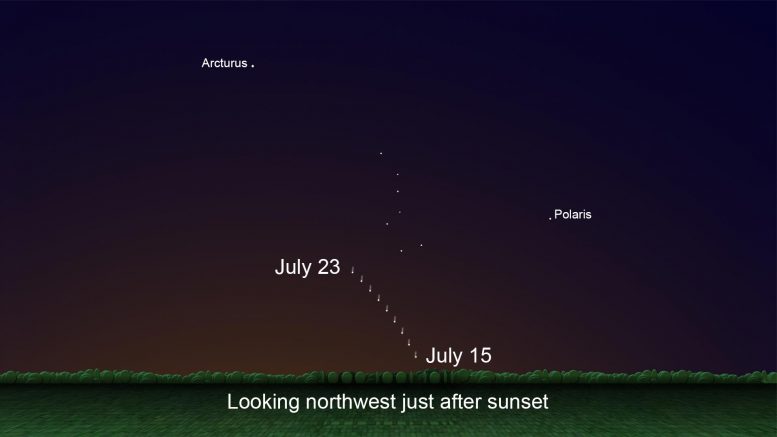
Skychart showing the location of Comet C/2020 F3 just after sunset, July 15 through 23. Credit: NASA/JPL-Caltech
The comet survived its recent closest approach to the Sun, and is now headed back toward the outer solar system, where it travels to a farthest distance of 715 astronomical units, or AU, from the Sun. (For comparison, Earth orbits at 1 AU, Jupiter at 5 AU, and Neptune at 30 AU.)
The comet takes about 6,800 years to make one lap around its long, stretched out orbit, so it won’t visit the inner solar system again for many thousands of years.
As summer begins, the daily periods of sunlight begin to shorten. For the Washington, D.C. area (using the location of NASA Headquarters), on the day of the full Moon (Sunday, July 5, 2020) morning twilight will begin at 4:37 a.m., sunrise will be at 5:49 a.m, solar noon will be at 1:13 p.m. when the Sun reaches its maximum altitude of 73.8 degrees, sunset will be at 8:36 p.m., and evening twilight will end at 9:48 p.m. By the day of the full Moon after next (Monday, August 3, 2020) morning twilight will begin at 5:06 a.m., sunrise will be at 6:11 a.m, solar noon will be at 1:14 p.m. when the Sun reaches its maximum altitude of 68.4 degrees, sunset will be at 8:17 p.m, and evening twilight will end at 9:22 p.m.
Jupiter and Saturn Watching
On the evening of July 4, 2020 (the evening before the full Moon after midnight on July 5), as evening twilight ends, the bright planet Jupiter and the fainter planet Saturn will appear in the east southeast, with Jupiter to the right about 6 degrees above the horizon and Saturn on the left about 3 degrees above the horizon. The bright star closest to appearing directly overhead will be Arcturus, appearing 64 degrees above the southwestern horizon. The three bright stars of the “Summer Triangle” will appear towards the east, with Vega appearing 55 degrees above the horizon in the east-northeast, Deneb about 35 degrees above the horizon to the lower left of Vega, and Altair in the east about 26 degrees above the horizon.
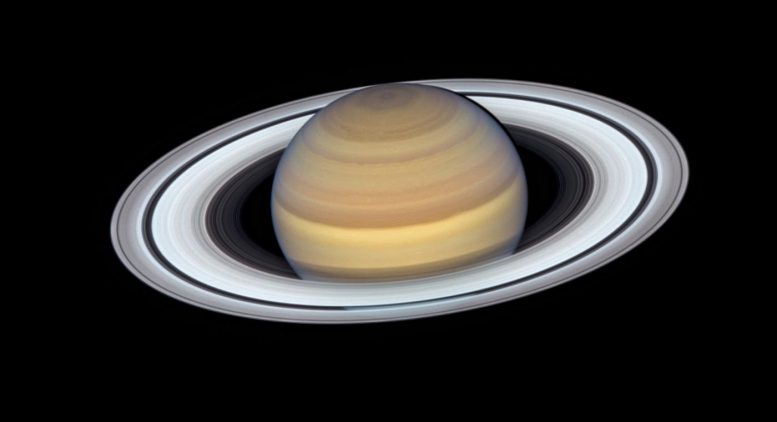
The latest view of Saturn from NASA’s Hubble Space Telescope captures exquisite details of the ring system — which looks like a phonograph record with grooves that represent detailed structure within the rings — and atmospheric details that once could only be captured by spacecraft visiting the distant world. Hubble’s Wide Field Camera 3 observed Saturn on June 20, 2019, as the planet made its closest approach to Earth, at about 845 million miles away. Credit: NASA, ESA, A. Simon (GSFC), M.H. Wong (University of California, Berkeley) and the OPAL Team
As the lunar cycle progresses, the background of stars and planets will appear to shift towards the west. This summer should be a great time for Jupiter and Saturn watching, especially with a backyard telescope. Jupiter will be at its closest and brightest for the year on July 14, 2020, while Saturn will be at its closest and brightest on July 20, 2020, (called “opposition” because they will be opposite the Earth from the Sun). Both will appear to shift towards the west over the summer months, making them visible earlier in the evening sky (and friendlier for backyard stargazing, especially if you have young ones with earlier bed times). With clear skies and a small telescope you should be able to see Jupiter’s four bright moons, Ganymede, Callisto, Europa, and Io, shifting positions noticeably in the course of an evening. For Saturn, you should be able to see the brightly illuminated rings as well as the motions of Saturn’s moons, particularly the largest moon, Titan.
Comet Watching
We may have a naked eye comet visible in the evenings later in July 2020. However, we had two other promising comets this year [C/2019 Y4 (ATLAS) and C/2020 F8 (SWAN)] that both broke up as they got closer to the Sun and did not end up being visible. This current comet, C/2020 F3 (NEOWISE), was discovered on March 27, 2020. It will make its closest approach to the Sun on July 3, passing closer to the Sun than Mercury. If (and this is a big if) it does not break up, in its current orbit it should make its closest pass by the Earth on July 23. For the Washington, D.C. area, we may be able to see it near its closest on July 22 after moonset (at 10:14 p.m. EDT), when it will be about 20 degrees above the horizon in the northwest, but before the comet sets in the north-northwest just after 1 a.m. on July 23, 2020.
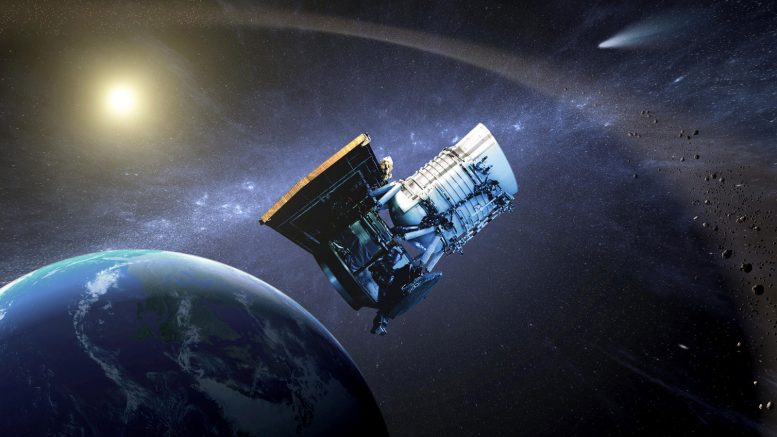
This artist’s concept shows the Wide-field Infrared Survey Explorer, or WISE, spacecraft, in its orbit around Earth. In its NEOWISE mission, it finds and characterizes asteroids. Credit: NASA/JPL-Caltech
This comet was discovered by NASA’s Near Earth Object Wide-field Infrared Survey Explorer (NEOWISE). NEOWISE was launched as the WISE mission on December 14, 2009, using stored liquid hydrogen to keep its long-wavelength and far infrared detectors cold for astronomy observations. After this stored cryogen ran out, it observed for four months using only its mid-wavelength infrared detectors. The spacecraft was put into hibernation in February 2011. In September 2013 it was revived to make observations in the mid-wavelength infrared looking for Near Earth Objects (NEOs). So far, NEOWISE has discovered 28 comets and 313 near Earth asteroids (NEAs), including 57 potentially hazardous asteroids (PHAs) that might someday make threatening close approaches to the Earth.
By the evening of the full Moon after next on August 3, 2020, as evening twilight ends (at 9:22 p.m. EDT for the Washington, D.C. area), the bright planet Jupiter and the fainter planet Saturn will appear in the southeast, with Jupiter to the right about 19 degrees above the horizon and Saturn on the left about 18 degrees above the horizon. The bright star appearing closest to overhead will be Vega, the brightest of the stars of the “Summer Triangle,” appearing 72 degrees above the eastern horizon. The other bright stars of the “Summer Triangle” are Deneb, which will appear about 50 degrees above the horizon in the east-northeast, and Altair, which will appear about 43 degrees above the horizon in the east-southeast.
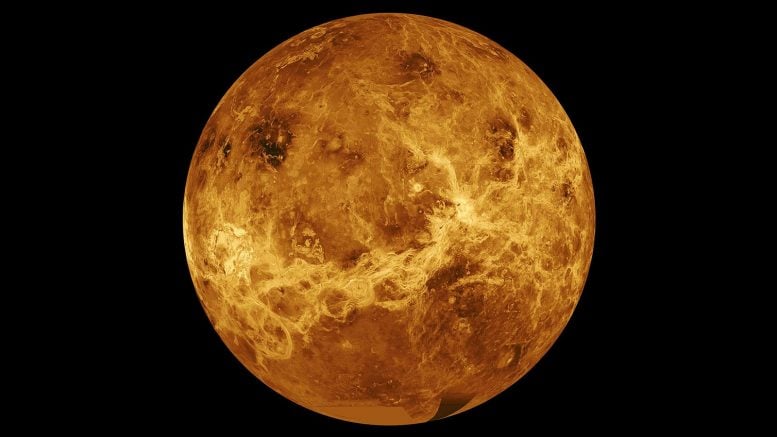
Venus hides a wealth of information that could help us better understand Earth and exoplanets. NASA’s JPL is designing mission concepts to survive the planet’s extreme temperatures and atmospheric pressure. This image is a composite of data from NASA’s Magellan spacecraft and Pioneer Venus Orbiter. Credit: NASA/JPL-Caltech
On the morning of the full Moon on Sunday, July 5, 2020, as morning twilight begins (at 4:37 a.m. EDT for the Washington, D.C. area), four visible planets will be above the horizon (Neptune and Pluto will also be above the horizon but are not visible without a telescope). Venus will be the brightest, appearing about 11 degrees above the horizon in the east-southeast near the bright star Aldebaran. Next in brightness will be Jupiter appearing about 18 degrees above the horizon in the southwest. Saturn (the faintest of the four) will appear to the upper left of Jupiter at about 23 degrees above the horizon. Mars, third in brightness, will appear about 42 degrees above the horizon in the southeast.
Venus and Mercury Watching
Wednesday morning, July 8, 2020, will be when the brightest of the planets, Venus, reaches its greatest brilliancy (a geometric approximation of its greatest brightness). The bright star appearing to the lower left of Venus will be Aldebaran. Also around July 8, 2020 (depending upon viewing conditions), the planet Mercury should begin emerging from the glow of dawn about 30 minutes before sunrise, appearing low on the horizon in the east-northeast. Venus and Aldebaran will appear at their closest to each other on the morning of Sunday, July 12, 2020, about 1 degree apart. Starting the morning of Thursday, July 16, 2020, the planet Mercury will be above the horizon at the time morning twilight begins (at least for the Washington, D.C. area), making all five of the naked eye planets visible (if you have a clear view of Mercury on the horizon in the east-northeast and Jupiter and Saturn on the horizon in the southwest). Mercury will appear at its highest above the horizon at the time morning twilight begins on the morning of Sunday, July 26, 2020 (3.5 degrees above the horizon in the east-northeast for the Washington, D.C. area), after which Mercury will begin shifting towards the glow of dawn again. Monday, July 27, 2020, will be the last morning that Jupiter will be above the horizon at the time morning twilight begins (for the D.C. area, at least).
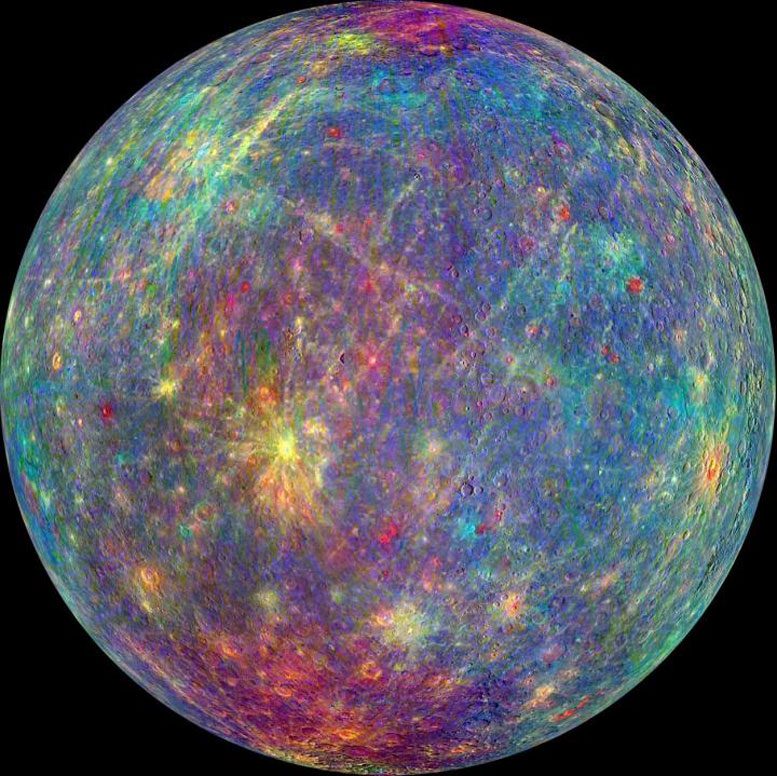
Though Mercury may look drab to the human eye, different minerals appear in a rainbow of colors in this image from NASA’s MESSENGER spacecraft. Credit: NASA/Johns Hopkins University APL/Carnegie Institution of Washington
By the morning of the full Moon after next on Monday, August 3, 2020, as morning twilight begins (at 5:06 a.m. for the Washington, D.C. area), the brightest of the visible planets, Venus, will appear about 25 degrees above the horizon in the east. Jupiter will have already set, so next in brightness will be Mars, appearing 54 degrees above the horizon in the south-southeast. Almost as bright as Mars, Mercury will appear only about 1 degree above the horizon in the east-northeast. The faintest of the visible planets, Saturn, will just be setting in the west-southwest, and this will be the last morning that Saturn will be above the horizon at the time morning twilight begins.
Meteor Showers
If you happen to find yourself in a place with clear, dark skies, away from city lights, especially if the Moon has already set and it is after midnight but before the sky starts to show any sign of dawn, keep a look out for meteors. Last month I mentioned the June Bootids, which peaked on June 27 and are expected to end by July 2, so I won’t write much more here. The Southern Delta-Aquariids are expected to be active from around July 12 to August 23, peaking on July 27, 2020. Under ideal conditions (a clear, dark night in the southern hemisphere) near this peak you might be able to see 25 meteors per hour, although fewer meteors are expected be visible for us in the northern hemisphere. The best time to look should be on Monday morning, July 27, 2020, after moonset (12:20 a.m. EDT for the Washington, D.C. area) and before any sign of dawn (before about 4:17 a.m.), but only if the weather is clear with no clouds or high hazes, you can find a place that has a clear view of a wide expanse of the sky especially towards the south, and it is a place that is far from any light sources or urban light pollution.
If you do go out looking for meteors, be sure to give your eyes plenty of time to adapt to the dark. The rod cells in your eyes are more sensitive to low light levels but play little role in color vision. Your color-sensing cone cells are concentrated near the center of your view with more of the rod cells on the edge of your view. Since some meteors are faint, you will tend to see more meteors from the “corner of your eye” (which is why you need a view of a large part of the sky). Your color vision (cone cells) will adapt to darkness in about 10 minutes, but your more sensitive night vision will continue to improve for an hour or more (with most of the improvement in the first 35 to 45 minutes). The more sensitive your eyes are, the more chance you have of seeing meteors. Even a short exposure to light (from passing car headlights, etc.) will start the adaptation over again (so no turning on a light or your cell phone to check what time it is).
The Perseids are expected to be active from July 17 to August 24, peaking on August 12, 2020. Since this peak will be after the full Moon after next, I’ll write more next month.
Even though they are not usually visible, I include in these Moon missives information about Near Earth Objects (mostly asteroids) that may pass the Earth within 5 lunar distances, because I find it interesting that we have discovered so many. Early on Monday morning, June 29, 2020, at 12:09 a.m. EDT (2020-Jun-29 04:09 UTC), Near Earth Object (2020 JX1), between 46 and 103 meters (152 to 339 feet) across, will pass the Earth at 3.3 lunar distances, traveling at 5.00 kilometers per second (11,180 miles per hour).
July 1, 2020
On Wednesday afternoon, July 1, 2020, at 4:27 p.m. EDT (2020-Jul-01 20:27 UTC), Near Earth Object (2020 MK3), between 18 and 41 meters (60 to 135 feet) across, will pass the Earth at 1.8 lunar distances, traveling at 8.35 kilometers per second (18,670 miles per hour).
July 2, 2020
On Thursday night, July 2, 2020, the bright star Antares will appear to the lower right of the waxing nearly-full Moon.
July 4, 2002
Saturday morning, July 4, 2020, the Earth will be at aphelion, its farthest from the Sun in its year-long orbit. The Earth will be 3.4% farther from the Sun than it was at perihelion in early January. Since light intensity drops off as the square of the distance from the light source, the sunlight reaching the Earth at aphelion will be about 6.5% less bright than sunlight reaching the Earth at perihelion.
July 5, 2020
As mentioned above, the next full Moon will be early Sunday morning, July 5, 2020, appearing opposite the Sun at 12:44 a.m. EDT. This will be a partial penumbral eclipse of the Moon, visible from most of North America, but the slight reduction in brightness on part of the Moon will be difficult to notice with the human eye. The Moon will start to enter the partial shadow on Saturday night, July 4, 2020, at 11:07 p.m. EDT. On Sunday morning at 12:30 a.m. (the peak of the eclipse) about 35 percent of the Moon will be in the partial shadow. The Moon will finish exiting the partial shadow of the Earth at 1:52 a.m.
On Sunday night into Monday morning, July 5 to 6, 2020, the full Moon and the planets Jupiter and Saturn will form a triangle. The Moon will appear in the southeast at about 3 degrees above the horizon as evening twilight ends, with Jupiter above the Moon and Saturn to the left of the Moon. The Moon will reach its highest in the sky for the night on Monday morning (at 2:11 a.m. EDT for the Washington, D.C. area), with Jupiter to the right and Saturn above, and the Moon will be about 19 degrees above the horizon in the southwest as morning twilight begins (at 4:38 a.m. EDT).
July 8, 2020
Wednesday morning, July 8, 2020, will be when the brightest of the planets, Venus, will reach its greatest brilliancy (a geometric approximation of its greatest brightness) for this apparition. The bright star appearing to the lower left of Venus will be Aldebaran. For the Washington, D.C. area, Venus will rise in the east-northeast at 3:29 a.m. EDT, Aldebaran will rise around 3:40 a.m., morning twilight will begin around 4:40 a.m., but Venus should be bright enough to remain visible well into dawn. Since Venus will be near aphelion (its farthest from the Sun in its orbit), Venus will not be as bright this apparition as it can be in other apparitions.
Also Wednesday morning (depending upon viewing conditions), the planet Mercury should begin emerging from the glow of dawn about 30 minutes before sunrise, appearing low on the horizon in the east-northeast (rising at 5:21 a.m. EDT for the Washington, D.C. area). Mercury passed between the Earth and the Sun on June 30, 2020.
July 11, 2020
On Saturday morning, July 11, 2020, the planet Mars will appear to the left of the waning gibbous Moon. For the Washington, D.C. area, Mars will rise about 8 degrees to the left of the Moon at 12:21 a.m. EDT and they will appear to move closer together until Mars is lost in morning twilight, which will begin at 4:42 a.m.
July 12, 2020
By Sunday morning, July 12, 2020, the waning gibbous Moon will appear to have shifted to the other side of the planet Mars. For the Washington, D.C. area, the Moon will rise in the east at 12:38 a.m. EDT with Mars appearing about 5 degrees to the upper right of the Moon, and morning twilight will begin at 4:43 a.m.
Also Sunday morning, Venus and Aldebaran will appear at their closest to each other, about 1 degree apart. For the Washington, D.C. area, Aldebaran will rise to the lower right of Venus in the east-northeast at 3:24 a.m. EDT and they will appear about 15 degrees above the horizon at the time morning twilight begins (at 4:43 a.m.).
Sunday afternoon, at 3:27 p.m. EDT, the Moon will be at apogee, its farthest from the Earth for this orbit. Sunday evening, the waning Moon will appear half-full as it reaches its last quarter at 7:29 p.m. EDT.
July 14, 2020
On Tuesday morning, July 14, 2020, the planet Jupiter will appear opposite the Sun as seen from the Earth (called “opposition”). Jupiter will be at its closest and brightest for this apparition, effectively a “full Jupiter,” rising around sunset and setting around sunrise.
July 16, 2020
Starting the morning of Thursday, July 16, 2020, the planet Mercury will be above the horizon at the time morning twilight begins (at least for the Washington, D.C. area). This will make all five of the naked eye planets visible (if you have a clear view of Mercury on the horizon in the east-northeast and Jupiter and Saturn on the horizon in the southwest).
July 17, 2020
On Friday morning, July 17, 2020, the brightest of the planets, Venus, will appear near the waning crescent Moon and the bright star Aldebaran. For the Washington, D.C. area, Venus will rise in the east-northeast at 3:11 a.m. EDT, with the crescent Moon to the upper left and the bright star Aldebaran to the upper right. By the time morning twilight begins (at 4:48 a.m.) Venus will be about 18 degrees above the horizon in the east, after which it will become harder to see Aldebaran and the crescent Moon as the sky lightens with dawn.
July 19, 2020
Sometime around Sunday, July 19, 2020 (2020-Jul-19 05:32 UTC with 1 day, 12 hours, 59 minutes uncertainty), Near Earth Object (2016 DY30), between 2 and 5 meters (7 to 15 feet) across, will pass the Earth at between 2.0 and 34.7 lunar distances (nominally 9.0), traveling at 15.09 kilometers per second (33,760 miles per hour).
Also Sunday morning, if you have a very clear view of the horizon in the east-northeast, you might be able to see the waning crescent Moon to the left of the planet Mercury. For the Washington, D.C. area, the pair will rise a few minutes before morning twilight begins, and will become more difficult to see as they rise farther and the sky brightens with dawn. If you use binoculars to look for the pair, be sure to stop looking well before sunrise!
July 20, 2020
Monday afternoon, July 20, 2020, at 1:33 p.m. EDT, will be the new Moon, when the Moon passes between the Earth and the Sun and will not be visible from the Earth. The day of or the day after the New Moon marks the start of the new month for most lunisolar calendars.
The planet Saturn will appear opposite the Sun as seen from the Earth (called “opposition”). Saturn will be at its closest and brightest for this apparition, effectively a “full Saturn,” rising around sunset and setting around sunrise.
July 21, 2020
The sixth month of the Chinese calendar starts on Tuesday, July 21, 2020 (at midnight in China’s time zone, which is 12 hours ahead of EDT).
Sundown on Tuesday, July 21, 2020, will mark the start of Av in the Hebrew calendar. In the Islamic calendar the months traditionally start with the first sighting of the waxing crescent Moon after the New Moon, although many Muslim communities now follow the Umm al-Qura Calendar of Saudi Arabia, which uses astronomical calculations to start months in a more predictable way.
Sunset on Tuesday evening will probably mark the beginning of Dhu al-Hijjah, the twelfth and final month of the Islamic year, a sacred month that is the month of the Hajj. Making the Hajj or pilgrimage to Mecca in Saudi Arabia at least once in your life is one of the Five Pillars of Islam. This year, because of the COVID-19 pandemic, Saudi Arabia has imposed considerable restrictions on the Hajj to protect the health and safety of all involved.
July 22, 2020
On Wednesday morning, July 22, 2020, the planet Mercury will reach its greatest westward separation from the Sun as seen from the Earth, called greatest western elongation. Because the angle of the Sun-Mercury line and the horizon is becoming more perpendicular, the date when Mercury appears highest above the horizon as morning twilight begins will be after when Mercury and the Sun appear farthest apart as seen from the Earth.
On Wednesday evening, if you have a clear view of the horizon in the west-northwest, you might be able to see the thin, waxing crescent Moon above the bright star Regulus. For the Washington, D.C. area, evening twilight will end around 9:36 p.m. EDT, Regulus will set about 18 minutes later at around 9:54 p.m., and the Moon will set around 10:14 p.m.
July 23, 2020
Keep an eye on the news, as this may change, but we might have a naked eye comet visible in the evenings in July 2020. Comet C/2020 F3 (NEOWISE) was discovered on March 27, 2020, and will make its closest approach to the Sun on July 3, 2020, passing closer to the Sun than Mercury. If (and this is a big if) it does not break up as it passes close to the Sun, in its current orbit it will pass its closest to the Earth on July 23, 2020. For the Washington, D.C. area, on Wednesday evening, July 22, 2020, we may be able to see this comet near its closest between moonset at 10:14 p.m. EDT when it will be in the northwest about 20 degrees above the horizon (and the light of the Moon will no longer interfere with comet viewing) and around 1 a.m. on July 23, 2020, when the comet will set in the north-northwest.
July 25, 2020
Early Saturday morning, July 25, 2020, at about 1 a.m. EDT, the Moon will be at perigee, its closest to the Earth for this orbit.
July 26, 2020
On Sunday morning, July 26, 2020, Mercury will appear at its highest above the horizon at the time morning twilight begins (3.5 degrees above the east-northeast horizon for the Washington, D.C. area), after which Mercury will begin shifting towards the glow of dawn again. Because the angle of the Sun-Mercury line and the horizon is becoming more perpendicular, Mercury will appear highest above the horizon as morning twilight begins four days after Mercury appeared farthest apart from the Sun as seen from the Earth.
On Sunday evening, the bright star Spica will appear about 7 degrees below the waxing, nearly half-full Moon. They will appear in the southwest as evening twilight ends and Spica will set first in the west-southwest (at 11:38 p.m. EDT for the Washington, D.C. area).
July 27, 2020
Monday morning, July 27, 2020, will be the last morning when Jupiter will be above the horizon at the time morning twilight begins (for the D.C. area, at least). The Moon will appear half-full as it reaches its first quarter at 8:33 a.m. EDT.
The Southern Delta-Aquariids are expected to be active from around July 12 to August 23, peaking on Monday, July 27, 2020. At the peak, under ideal conditions (a clear, dark night in the southern hemisphere) you might be able to see 25 meteors per hour, although fewer meteors will be visible for us in the northern hemisphere. If the weather is clear with no clouds or high hazes, you find in a place with a clear view of a wide expanse of the sky (especially towards the south) that is far from any light sources or urban light pollution, the best time to look should be on Monday morning, July 27, 2020, between moonset (after 12:20 a.m. EDT for the Washington, D.C. area) and any first signs of dawn (before about 4:17 a.m.).
July 29, 2020
On Wednesday night into early Thursday morning, July 29 to 30, 2020, the bright star Antares will appear about 5 degrees below the waxing gibbous Moon. For the Washington, D.C. area, evening twilight will end around 9:28 p.m. EDT when the Moon will be 30 degrees above the horizon in the south. Antares will set before the Moon in the southwest Thursday morning at about 1:34 a.m.
August 1, 2020
On Saturday morning, August 1, 2020, if you have a clear view of the horizon in the east-northeast, you might be able to see the bright star Pollux about 7 degrees to the upper left of the planet Mercury. For the Washington, D.C. area, Mercury will rise at about 4:49 a.m. EDT and will be only about 2 degrees above the horizon at the time morning twilight begins at 5:04 a.m.
Saturday also is Lammas Day, a Christian holiday celebrated in some English-speaking countries that may have derived from earlier pagan celebrations. We currently divide the year into four seasons based upon the solstices and equinoxes, with summer ending on the autumnal equinox in September. This approximates summer as the quarter of the year with the warmest temperatures. The Celts and other pre-Christian Europeans celebrated “cross-quarter days” halfway between the solstices and equinoxes, and divided the seasons on these days. Using this definition, summer was approximately the quarter of the year with the longest daily periods of daylight, with summer traditionally ending August 1st (the middle of our summer). Names for this end of summer and start of fall harvest season include Lughnasadh, Lughnasa, Lúnasa, Lùnastal, and Luanistyn.
August 2, 2020
On Saturday night into Sunday morning, August 1 to 2, 2020, the bright planet Jupiter will appear above the waxing gibbous Moon with Saturn appearing to the left to form a triangle. For the Washington, D.C. area, the Moon will be about 17 degrees above the horizon in the southeast as evening twilight ends at 9:24 p.m. EDT. The Moon will reach its highest in the sky for the night just after midnight on Sunday morning (at 12:01 a.m.), and Jupiter will set first in the west-southwest at 4:35 a.m., followed by the Moon (at 4:49 a.m) and Saturn (at 5:14 a.m.).
August 3, 2020
Monday morning, August 3, 2020, will be the last morning that Saturn will be above the horizon at the time morning twilight begins (for the Washington, D.C. area, at least).
Sometime around Monday, August 3, 2020 (2020-Aug-03 23:36 UTC with 1 day, 14 hours, 25 minutes uncertainty), Near Earth Object (2018 BD), between 3 and 6 meters (8 to 19 feet) across, will pass the Earth at between 3.8 and 24.4 lunar distances (nominally 7.5), traveling at 9.41 kilometers per second (21,060 miles per hour).
The full Moon after next will be mid-day on Monday, August 3, 2020, appearing opposite the Sun in Earth-based longitude at 11:59 a.m. EDT.

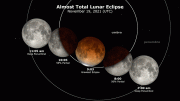
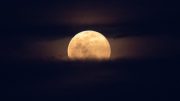
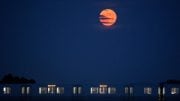

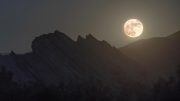
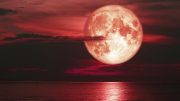

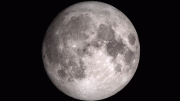
What about viewing these events from different locations? I’m in Miami and would love to know when they would be most easily visible for me. Great information will share with friends.
Agreed, would like to know pacific time as well.